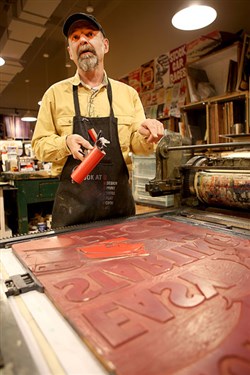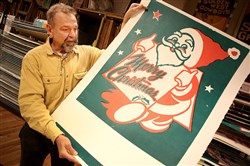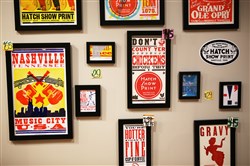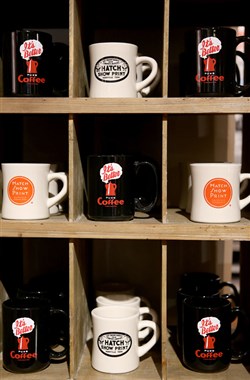VOL. 38 | NO. 45 | Friday, November 7, 2014
Suddenly trendy Hatch Show Print offers unique gifts
By Jeannie Naujeck

Hatch Show Print’s master printer, Jim Sherraden, inks a plate in preparation of making a print.
-- Michelle Morrow | The LedgerGot one of those people on your gift list who “has everything?”
Chances are they don’t have a Hatch monoprint.
Whether your hard-to-buy-for recipient lives in Nashville or out of town, these iconic prints not only encapsulate the essence of the South, but they have entered the American design lexicon and are considered bona fide works of fine art.
Thanks in part to a national traveling exhibit with the Smithsonian Institution, traditional Hatch prints have appeared everywhere from the popular design blog ApartmentTherapy.com to Sunset magazine and the set of the TV show Modern Family.
At the Hatch Show Print design shop and gallery, now part of the Country Music Hall of Fame and Museum, visitors can purchase poster-sized restrikes of vintage advertisements and classic images from the shop’s 135-year history.

Sherraden displays a two-color poster created in the shop.
-- Michelle Morrow | The LedgerBut the most special pieces are one-of-a-kind creations called monoprints that come from the mind and hands of artist and master printer Jim Sherraden.
Formerly the shop manager, Sherraden now devotes his time to designing and creating art from original woodblocks from the collection, such as one carved for the Peco Gas company which was located on the corner of 12th Avenue and Division Street.
He’ll hand-ink portions of the old woodblock and combine them with new, one-of-a-kind images, blocking them out into original designs “quilted” together with painted “stitching.” The end result is a vibrant, wholly unique work of art that is both a contemporary interpretation and a celebration of the rich tradition of the plates.
Sherraden’s original monoprints sell for anywhere from $650 to well over $1,000.
“These are one of the more successful directions I’ve been able to take this original archive – the quilted one-sheets,” he says.

Chances are you’ll find a print that will interest everyone on your shopping list without giving the same print twice.
-- Michelle Morrow | The Ledger“And I got to thinking, ‘Why are they so popular?’ They are everything that Hatch is.”
Hatch posters were originally designed as advertising. Established in 1879, Hatch Show Print created from carved woodblocks posters that were glued to the sides of barns and buildings throughout the South to advertise events like concerts, carnivals, movies, races and rodeos.
“When you look at the archives of the shop you’ll see the movable type and you’ll also see these incredible woodblocks that were carved once and carved well, historically, so you could use them year after year, town after town,” Sherraden says, as he guides visitors around the shop.
“This is the true depth of the collection,” he says, pointing out the carved woodblocks that line the walls like a library.
But make no mistake. Hatch Show Print is a working museum, a revenue-generating enterprise where young designers reference the archives to create commemorative posters that clients like musical artists Santana, Wilco, Arcade Fire, Jason Isbell and Mary Chapin Carpenter will sell at concerts as souvenir items.
Hatch-designed posters are often the top-selling items at merchandise tables during shows at the Ryman Auditorium.
“They are, in essence, putting a contemporary spin on the traditional, functioning, tell-you-or-sell-you style of printing,” Sherraden says.
“At Hatch, your designer is your printer. Designing and printing were never separated. They all reference the archive for inspiration but they also carve new blocks to add to the collection. That’s what we do it at Hatch. That’s our tradition.”
The rise of Hatch prints in the design world dates to 1986, when Sherraden started restriking the old blocks to document and archive the collection.
At the time, no one dreamed that anyone would want to buy them, much less frame and hang them on their living room walls. But when a visitor from California said she wanted to order prints for her staff, Sherraden began to see a larger market.

In addition to posters, Hatch Show Print offers a wide variety of products including hats, T-shirts, mugs, coasters and aprons.
-- Michelle Morrow | The Ledger“And when I started restriking these on the acid-free art paper, to borrow a line from Leonard Cohen, the imagery rose to play a higher part,” he says.
Those images now have a fitting showcase.
The relocation of the Hatch print shop from its creaky old building on Lower Broadway to its new space at the Hall has made it more accessible to a wider range of visitors.
It also gave rise to the Haley Gallery, which displays and sells restrikes of popular prints such as advertisements for Peco Gas and Airstream trailers, as well as Sherraden’s monoprints on acid-free paper and other media and the work of visiting artists.
Even with his work on display in a fine gallery on one of the most visible streets in Nashville, Sherraden remains modest, remarking with wry humor on the time he now spends giving interviews.
“I am no more or less talented than anybody else here,” he insists.
“These blocks are what I am most familiar with, so my job is, how can I celebrate the shop and create a revenue stream with those pieces of the archive that I am most familiar with? This is the best kind of legacy that I can leave, is to create this artwork.”